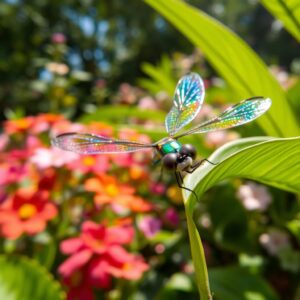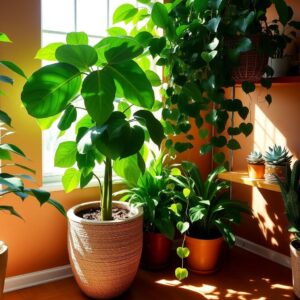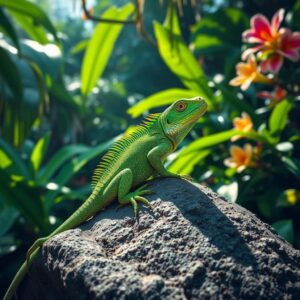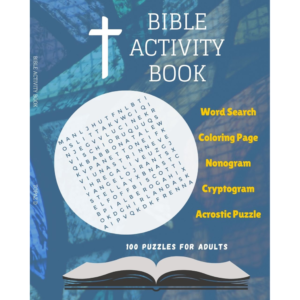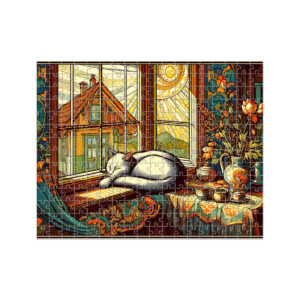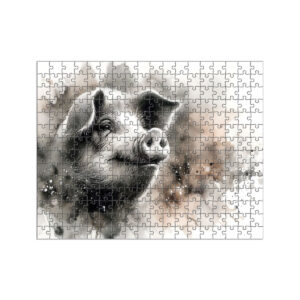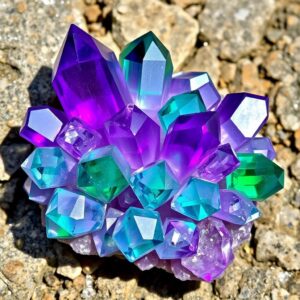
Explore & Play
Discover interesting topics and solve the accompanying crossword puzzle.
Nymph Crossword | Unveiling the Myths of Greek Nymphs
Table of Contents
Nymph Crossword
You can either fill in the crossword puzzle directly on this page or click the button in the bottom right corner to print it for free.

The Mythical Women of the Forest, Sea, and Sky: A Study of Greek Nymphs
Greek mythology is filled with fascinating and powerful female figures, none more enchanting than the nymphs, the mythical spirits that inhabit the natural world, from the deepest seas to the tallest trees. These divine entities represent the spirits of nature and play crucial roles in many myths and stories. In this article, we will delve into the various types of nymphs, their roles, transformations, relationships with gods, and the cultural significance they held in ancient Greek society.
As you read, you might also want to take a break and challenge yourself with our nymph-themed crossword puzzle, which features many of the words we’ll discuss in this article!
1. What Are Nymphs?
1.1. Defining Nymphs
Nymphs, derived from the Greek word nymphē, meaning “young woman,” were considered divine spirits of nature in ancient Greek mythology. These creatures were neither fully gods nor humans but were thought to be nature’s living spirits, inhabiting the world’s forests, mountains, rivers, lakes, and oceans. Nymphs were associated with fertility, beauty, and the primal forces of nature, embodying both the gentleness and the power of the natural elements.
These ethereal beings were often depicted as beautiful young women, full of life and grace, who interacted with gods and mortals alike. Their existence tied them to various natural realms, where they were seen as caretakers or protectors, ensuring the prosperity and balance of the ecosystems they inhabited.
1.2. Nymphs and Their Divine Power
The nymphs wielded a form of divine power that was directly linked to the forces of nature they embodied. For example, water nymphs controlled the flow of rivers and seas, while tree nymphs were believed to have a direct influence on the health and growth of forests. Their connection to the earth and natural cycles meant that nymphs were both feared and revered, as they held the power to bless or curse mortals based on their relationship with nature.
In many stories, nymphs were also seen as symbols of unchanging beauty and life force, often depicted as eternal virgins. However, their ability to alter the course of nature — or even to metamorphose into trees, rocks, or other natural features — demonstrated their profound connection to the physical world.
2. The Different Types of Nymphs
2.1. Water Nymphs: Naiads and Nereids
Water nymphs were often depicted as beautiful maidens who inhabited rivers, lakes, seas, and oceans. These nymphs had a particular connection to water, and their moods were thought to be reflective of the state of the water bodies they resided in.
Naiads were the nymphs associated with fresh water sources like rivers, streams, and springs. Their waters were vital for the fertility of the land, and these nymphs were believed to be capable of healing ailments and granting blessings to mortals. A famous example is Callirhoe, a Naiad whose waters could cure illness.
On the other hand, Nereids were the daughters of the primordial sea god Oceanus, and they inhabited the Mediterranean and other seas. Often depicted as joyful and beautiful, the Nereids were close companions to Poseidon, the god of the sea. One of the most famous Nereids was Galatea, whose love story with the Cyclops Polyphemus is told in many myths.
2.2. Tree Nymphs: Dryads and Hamadryads
Tree nymphs were spirits tied to specific trees. Their lives were deeply connected to the vitality of the trees they guarded, and they were often considered protectors of the forest.
Dryads were the most well-known tree nymphs, particularly associated with oak trees. The Hamadryads, however, were even more intimately connected to their trees, as they were believed to die if the tree they were tied to perished. A well-known myth about Phyllides shows how Dryads could fall in love with mortals, creating some of the most touching stories of love and transformation.
In another example, Alseids, the nymphs of the glades and meadows, took care of flowering trees and wildflowers. Their duties included ensuring the health of forests and fields, and their presence was seen as a sign of natural fertility.
2.3. Mountain Nymphs: Oreads
Mountain nymphs, or Oreads, were spirits of the mountains, hills, and caves. These nymphs were considered both wild and untamed, as they lived in the rugged terrain that symbolized the harsh beauty of nature’s highest points.
The Oreads were often depicted as energetic and sometimes fierce, embodying the spirit of mountainous landscapes. A famous Oread was Auloniad, who was known for her connection to the tranquil valleys between the hills.
2.4. Flower and Plant Nymphs
In addition to trees and water, nymphs were also associated with flowers and plants. Anthousai, the nymphs of flowers, were known for their colorful, fragrant beauty. They were thought to bring forth the blooms that nourished the world’s meadows and fields, linking the blooming seasons with their magical abilities to control plant life.
One of the most famous stories about a plant-associated nymph is that of Syrinx, who, in an effort to escape the pursuit of the god Pan, transformed herself into reeds. These reeds would later be used to create the syrinx (a musical instrument), symbolizing her escape.
3. Nymphs and Their Transformations
3.1. Daphne: The Laurel Tree
Perhaps one of the most iconic nymph transformations in Greek mythology is the story of Daphne, who was turned into a laurel tree to escape Apollo’s advances. In this myth, Apollo, struck by Cupid’s arrow, falls in love with Daphne, who wishes to remain untouched by the god’s affections. To save herself, she calls upon her father, the river god Peneus, who turns her into a laurel tree. The laurel became sacred to Apollo, and the tree continues to symbolize eternal honor and victory.
3.2. Syrinx: From Nymph to Reeds
Another tragic transformation involves Syrinx, a nymph who, in an attempt to avoid Pan’s advances, is turned into reeds by the river god. Pan, heartbroken and desperate, uses the reeds to make a musical instrument, known as the syrinx. This story highlights the recurring theme of nymphs becoming part of the natural world as a way of escaping divine desire or unwanted attention.
3.3. Callisto: The Bear
The myth of Callisto is a reminder of the punishments that nymphs sometimes faced at the hands of the gods. Callisto was a nymph who caught the eye of Zeus, and after Zeus’ wife, Hera, discovered their affair, she turned Callisto into a bear. Her tragic fate serves as a cautionary tale about the jealousy of the gods, and her transformation was later reversed when she was placed in the sky as the constellation Ursa Major.
3.4. Io: The Cow
Another transformation story is that of Io, who was transformed into a cow by Zeus in an attempt to protect her from his jealous wife, Hera. Though her transformation allowed her to escape Hera’s wrath, Io’s life became one of constant suffering and wanderings, symbolizing the eternal struggle between mortals and gods. Eventually, Io regained her human form, but her myth serves as an illustration of the vulnerability of nymphs to the whims of the gods.
4. Famous Nymphs and Their Stories
4.1. Echo: The Rejected Nymph
Echo is one of the most tragic nymphs in Greek mythology. Once a beautiful and talkative nymph, Echo attracted the ire of Hera, who cursed her to only repeat the last words spoken to her. This curse was a punishment for distracting Hera while Zeus carried on his romantic affairs. Echo’s love for Narcissus, the handsome youth who rejected her, ultimately led her to fade away into the mountains, her voice lingering as an echo in the hills.
4.2. Arethusa: The River Nymph
The myth of Arethusa, a river nymph, highlights the themes of pursuit and escape. When Arethusa was pursued by the river god Alpheus, she fled across lands and seas, finally asking Artemis for help. In response, Artemis turned Arethusa into a spring, which became a part of the Alpheus River, symbolizing the ever-flowing nature of water and the nymph’s desire to remain free from unwanted advances.
4.3. Thetis: The Mother of Achilles
Thetis, a sea nymph and the mother of the hero Achilles, played a crucial role in the Trojan War. As one of the Nereids, Thetis had the ability to change her form and could even become an animal, a skill she used to escape unwanted attention. Her story is significant not only because of her son’s heroism but also because of her role in trying to protect Achilles from his fate.
5. Nymphs and Their Relationships with Gods
5.1. Nymphs and Their Divine Lovers
Many nymphs had romantic relationships with gods, resulting in powerful offspring or tragic outcomes. For example, the Nereids, daughters of Oceanus, were often lovers of gods like Poseidon, and their children were considered important mythological figures. Other nymphs, like Callisto and Io, had relationships with Zeus, leading to both divine intervention and transformation.
5.2. Nymphs as Divine Daughters
Some nymphs were the daughters of major gods or Titans, and they played significant roles in shaping mythological events. The Nereids were the daughters of Oceanus and Tethys, and they were beloved by the gods for their beauty and grace. Their stories often involve interactions with gods and heroes alike.
5.3. The Role of Nymphs in Heroic Myths
Nymphs were not only romantic figures; they also played vital roles in heroic myths. Many nymphs aided heroes such as Odysseus and Hercules in their quests. For instance, Arethusa helped Alpheus, and Calypso played a significant part in Odysseus’s journey home.
The Enduring Legacy of Nymphs in Greek Mythology
Nymphs remain a powerful symbol in Greek mythology, representing the close relationship between the divine and the natural world. They embody the beauty, complexity, and wildness of nature, and their interactions with gods, mortals, and other mythical creatures continue to captivate us today. Whether through tragic transformation or their protective roles in nature, the legacy of nymphs endures in the stories and symbols we still cherish.
Time to Test Your Knowledge!
Now that you’ve learned about these fascinating mythical figures, challenge yourself with our Nymph-themed Crossword Puzzle to reinforce your understanding of these incredible characters and their stories.
Share to...
I hope you enjoy the content.
Want to receive our daily crossword puzzle or article? Subscribe!
You may also be interested in
Share to…
Want to receive our daily crossword puzzle?
-
Jigsaw Puzzles
Fjord Elegance: Abstract Jigsaw Puzzle 250 | 300 | 500 Pieces
kr 348,00 – kr 439,00Price range: kr 348,00 through kr 439,00 Select options This product has multiple variants. The options may be chosen on the product page -
Jigsaw Puzzles
Cozy Art Nouveau Cat Puzzle 250 | 300 | 500 Pieces
kr 348,00 – kr 439,00Price range: kr 348,00 through kr 439,00 Select options This product has multiple variants. The options may be chosen on the product page -
Jigsaw Puzzles
Elegant Pig Zodiac Watercolor Jigsaw Puzzle 250 | 300 | 500 Brikker
kr 348,00 – kr 439,00Price range: kr 348,00 through kr 439,00 Select options This product has multiple variants. The options may be chosen on the product page
